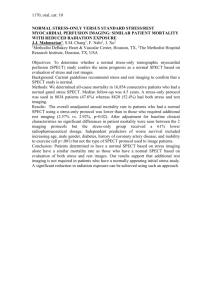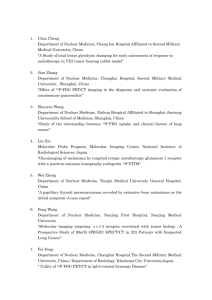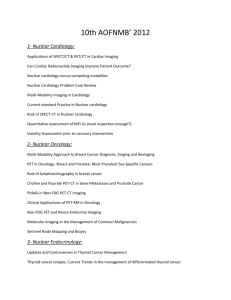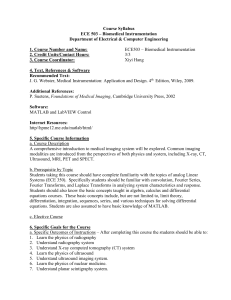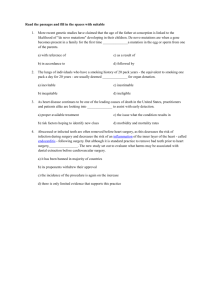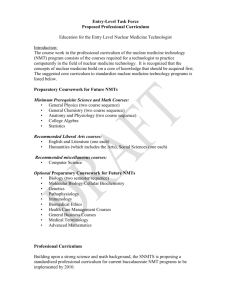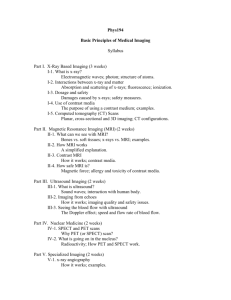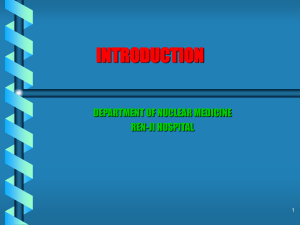Annual Work Plan Year: 2013
advertisement
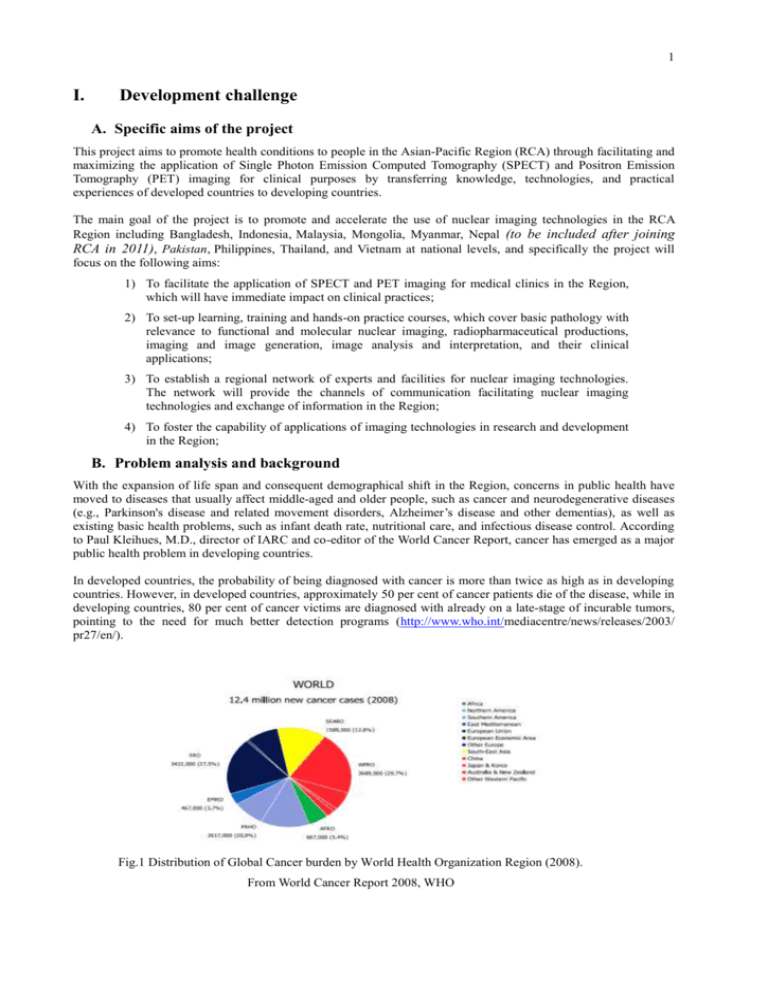
1 I. Development challenge A. Specific aims of the project This project aims to promote health conditions to people in the Asian-Pacific Region (RCA) through facilitating and maximizing the application of Single Photon Emission Computed Tomography (SPECT) and Positron Emission Tomography (PET) imaging for clinical purposes by transferring knowledge, technologies, and practical experiences of developed countries to developing countries. The main goal of the project is to promote and accelerate the use of nuclear imaging technologies in the RCA Region including Bangladesh, Indonesia, Malaysia, Mongolia, Myanmar, Nepal (to be included after joining RCA in 2011), Pakistan, Philippines, Thailand, and Vietnam at national levels, and specifically the project will focus on the following aims: 1) To facilitate the application of SPECT and PET imaging for medical clinics in the Region, which will have immediate impact on clinical practices; 2) To set-up learning, training and hands-on practice courses, which cover basic pathology with relevance to functional and molecular nuclear imaging, radiopharmaceutical productions, imaging and image generation, image analysis and interpretation, and their clinical applications; 3) To establish a regional network of experts and facilities for nuclear imaging technologies. The network will provide the channels of communication facilitating nuclear imaging technologies and exchange of information in the Region; 4) To foster the capability of applications of imaging technologies in research and development in the Region; B. Problem analysis and background With the expansion of life span and consequent demographical shift in the Region, concerns in public health have moved to diseases that usually affect middle-aged and older people, such as cancer and neurodegenerative diseases (e.g., Parkinson's disease and related movement disorders, Alzheimer’s disease and other dementias), as well as existing basic health problems, such as infant death rate, nutritional care, and infectious disease control. According to Paul Kleihues, M.D., director of IARC and co-editor of the World Cancer Report, cancer has emerged as a major public health problem in developing countries. In developed countries, the probability of being diagnosed with cancer is more than twice as high as in developing countries. However, in developed countries, approximately 50 per cent of cancer patients die of the disease, while in developing countries, 80 per cent of cancer victims are diagnosed with already on a late-stage of incurable tumors, pointing to the need for much better detection programs (http://www.who.int/mediacentre/news/releases/2003/ pr27/en/). Fig.1 Distribution of Global Cancer burden by World Health Organization Region (2008). From World Cancer Report 2008, WHO 2 Fig. 2 Estimated Global Cancer Burden (Numbers of new cases of cancer per annum). From World Cancer Report 2008, WHO Additionally, dementia has become a serious public health problem in developing countries. In 2001, 60.1% of total population with dementia lived in developing countries, and it is expected to rise up to 64.5% in 2020 and 71.2% in 2040 respectively. The rate of increase in numbers of people with dementia is predicted to be three to four times higher in developing areas than in developed regions –(Ferri et al., Lancet 2005). Therefore, it is expected that early detection of cancers and dementia in developing countries will increase life expectancy and improve quality of life in the Region. Fig. 3 Number of people with dementia in developed and developing countries (Ferri et al., Lancet 2005;366:2112-17) Nuclear imaging technologies enable us to identify functional and molecular changes in the living body, which precede morphological and structural changes. They make it possible to detect unhealthy conditions earlier, monitor their progressions, and evaluate their responses to therapeutic measures. Furthermore, with the advent of these imaging technologies, it has become possible to recognize specific biological processes at molecular levels non-invasively, serially, and quantitatively for health and disease matters. SPECT/PET imaging technologies have been widely used for the diagnosis and evaluation of cancerous and neurodegenerative conditions. They play significant roles in early detection and diagnosis, treatment planning, and monitoring of therapeutic responses of these diseases. C. Benefits of the project The advantages of SPECT/PET imaging technology can be signified by their clinical applications. The higher spatial and temporal resolutions on PET and further availability in radiopharmaceutical uses enable visualization of metabolism, perfusion, neuro-transmission, and pathology information other than anatomical changes with the application of the appropriate radio-tracers. These amplified functions allow its applications in the fields of Neurology (Epilepsy, dementia, cerebro-vascular disease diagnosis and therapeutic effect evaluations), Oncology (Cancer screening, staging, recurrence detection and re-staging) and Cardiology (Coronary artery disease, myocardial viability determination). Recently, there are growing numbers of nuclear SPECT and PET imaging devices and facilities in developing countries in the region, especially in the South-East Asian region, which possibly could grow exponentially within the next 5-10 years. However, these countries suffer from a lack of imaging technologies and their application techniques, qualified personnel, and regional/international cooperative activities, which prevent them from efficient 3 and maximized utilization of imaging devices and facilities both for clinical and research purposes. Therefore, this project aims to facilitate and maximize the application of SPECT and PET imaging for clinical sciences by transferring knowledge, technologies, and practical experiences of developed countries to developing countries, which will reduce the gaps in knowledge, technologies, and human resources between developing and developed countries and help realize a harmonized progression of nuclear medicine sciences in the Region. Furthermore, this project will stimulate demands for nuclear imaging devices and facilities and facilitate their early establishment and practical applications in the countries that currently have limited infrastructure. II. Strategy Korea and Australia possess a high level of well qualified individuals and correspondingly well established equipment used for nuclear medicine, and will provide human resources and training infrastructures in this project. In case of Korea, the manpower in the field of nuclear medicine consists of 147 nuclear medicine physicians, 817 nuclear medicine technologists and 113 nuclear scientists. Additionally, there are 127 PET machines and 207 SPECT machines throughout the nation. With the advent of FDG (fluorodeoxyglucose), PET is widely used in neurology, cardiology, and oncology and became essential in medical practices. About 248,000 PET studies were conducted in 2008, and 90% of them were related to oncology. Cardiology and neurology are the main applications of SPECT. A total of 15,500 brain perfusion SPECT and 78,000 myocardial perfusion SPECT were performed in 2008. As PET and SPECT machines can visualize to cellular and molecular levels, its utilization is growing in medical practices as well as researches. Recently, the Ministry of Education, Science and Technology (MEST) has established a comprehensive plan to promote SPECT and PET technologies in other countries. Supported by Korean governmental grants, transferring the nuclear medicine technology will improve the quality of medical practices and enrich the research capacities in the Region. Technologies will be transferred through the project using strategies such as train-the-trainees, on-site regional workshops, hands-on practices, interactive and customized training courses, and intra/inter-regional networking, including pathology that is relevant to nuclear imaging, radio-pharmaceutical production, image acquisition and reconstruction, image analysis/interpretation and clinical applications, neurochemistry imaging technologies, and molecular oncologic imaging technologies. This will contribute to the progress of clinical sciences by augmenting the application of imaging technologies and maximizing the use of imaging instruments and facilities and enhancing science capabilities in the Region. The RCA (Regional Cooperative Agreement for Research, Development and Training Related to Nuclear Science and Technology for Asia and the Pacific) consists of 17 Member States and has been recognized as an effective partner in providing nuclear technologies that enhance socio-economic wellbeing and contribute to sustainable development in the region. RCA Regional Office (RCARO) on behalf of RCA, has promoted the peaceful uses of nuclear technology to assist in addressing regional and national needs as a part of its activities. This project has been initiated by RCARO on behalf of RCA and was approved as a partnership project with UNDP at the RCA General Conference Meeting held in September 2009 for implementation. RCARO is responsible for overall management and implementation arrangement of the project as well as provision of matching funds. Further, as a project secretariat, RCARO will invite participants from Bangladesh, Indonesia, Malaysia, Myanmar, Mongolia, Nepal (to be included after joining RCA in 2011), Pakistan, Philippines, Republic of Korea, Singapore, Thailand, and Vietnam. RCA Regional Office will lead the project with the support of RCA Member States and work in conjunction with Seoul National University, Seoul, Korea, which is the project leading country coordinator and the leading technology provider. The Department of Nuclear Medicine of Seoul National University, which has been designated as IAEA Collaborating Center for Nuclear Medicine and Molecular Imaging in December 2004, is dedicated to research, educate and train nuclear medicine technologies and their clinical applications, covering project work plans thoroughly. This project will be also conducted in collaboration with IAEA/RCA, ARCCNM (Asian Regional Cooperative Council for Nuclear Medicine), ASNM (Asian School of Nuclear Medicine), and local societies of nuclear medicine. 4 The specific roles of each institute/stake holder are as following: A. RCARO/KAERI Management of the project Technological needs feedback Evaluation of the project outcome Establishing strategies for sustainability Providing matching funds Technology transfer via training courses and workshops Providing human resources and training infrastructures Establishing networks Establishing strategies for sustainability Participating in training protocol development Reporting regional status of technology and technology needs feedback Assisting in selecting appropriate trainees On-site application and dissemination, and report of the outcome at national level Establishing networks at national level B. Main technology providers (Korea) C. Role of recipients and Beneficiaries Fig. 4 Implementation strategy of the project 5 III. Results Intended Outcome: With the successful accomplishment of the project, it is expected that the levels of nuclear imaging and its application capabilities will be enhanced in participating countries from RCA region in terms of knowledge (up to 80% of developed countries), technology (up to 70%), and human resources (up to 60%). Outcome indicators: Improvement in MDG indicators for partner countries. Partnership Strategy: UNDP SU/SSC and MEST will enlist the expertise of Korean institutions and other developing country institutions. SU/SSC will also bring in the collaboration of specialized UN Agen cies for the projects that relate to their area of expertise. Project Title and ID: Promoting and Accelerating Nuclear SPECT/PET Imaging Technologies in the Region Project ID: Output Targets Enhancement of basic capacity of SPECT/PET imaging science and technology in 8 participating countries 1.1. Capacity upgrade of basic background knowledge of SPECT/PET imaging for selected participants (In 2011-12) 1.1.1. Developments of training course protocol (designing: curricula, teaching materials and teacher training programmes) 1.1.2. Basic training on SPECT/PET imaging science and technology 1.1.3. “Train-the-Trainers” Courses -Basic path physiology related to SPECT/PET imaging -Basic principles of SPECT/PET instrumentation -Radiopharmaceutical production -Image acquisition and reconstruction -Image analysis and interpretation 1.1.4. On-site regional workshops 1.1.5. Hands-on practices Facilitation of Nuclear imaging-training including radiochemistry and medical physics in 8 Participating countries 2.1 Build-up of practices and skills for selected participants using SPECT/PET equipment and facilities (in 2012-13) Training on SPECT/PET imaging application technologies for medical clinics(inc. neurodegenerative and oncologic disorders) Hands-on practices -SPECT/PET management system -Clinical applications -Reporting system of nuclear imaging results “On-site regional workshops 2.1.5 Evaluation of Training Courses MEST, UNDP SU/SSC, RCARO/KAE RI, Korea SNU, ARCCNM ASNM Participating countries Consultations Training Publications Travel Resource people Miscellaneous Establishing network of experts and facilities for nuclear imaging technologies 3.1. Intra/interregional networking establishment (In 2013) 3.1.1. Establishing Intra/inter-regional networks 3.1.2. Establishing expert networks 3.1.3. Interactive web-based protocols and systems 3.1.4. Networking activity reports 3.1.5. Establishing strategies for sustainability Consultations Publications Travel Resource people Miscellaneous $50,000 Completing and evaluating project 4.1. Review and valuation of the project (In 2013) 4.1.1. Review meetings 4.1.2. In-depth feedback of training courses 4.1.3. Final Project evaluation MEST, UNDP SU/SSC, RCARO/KAE RI, Korea SNU, ARCCNM ASNM Participating countries MEST, UNDP SU/SSC, RCARO ?KA ERI, Korea SNU, ARCCNM ASNM Participating countries Total Indicative activities Collaboratin g partners MEST, UNDP SU/SSC, RCARO/KAE RI, Korea SNU, ARCCNM ASNM Participating countries Intended outputs Inputs Consultations Training Publications Resource people Travel Miscellaneous $150,000 $250,000 Training Workshops $50,000 $300,000 From UNDP SU/SSC); $200,000 from RCARO) 7% GMS Total + GMS *The indicative activities are subject to the circumstances of the progress of the project. 6 Annex 1. In-kind Contributions Estimation of In-Kind Contributions by SNU (December 2010-December 2013) Type of contribution Description of item Estimation 1 Personnel cost Work of project manager, assistant, accountant, expert, consultant, lecturer and volunteers * 42 person for 36 months= $ 226,800 2 Books, leaflets or any other printed material $ 4,000 3 Author work for creation of teaching protocol and materials Use of equipments $ 20,000 4 Use of facility Use of nuclear medicine equipments and workstations ** Rent for meeting hall/room for training and class rooms 5 Supplies and material Supplies for offices and laboratories $ 50,000 6 Use of software Cost of software license for period of use $ 12,000 7 Communication Phone, internet and post $ 1,000 8 Use of vehicles/fuel Cost of vehicle rent/fuel $ 3,000 Total $ 3,000*6=$ 18,000 $ 334,800 1) Major facilities and equipments contributed by SNU - Cyclotron - Full service radiopharmacy (including hot cells and chemistry laboratory) - Gamma camera - PET/CT - PET/MR - SPECT/CT - Small animal PET/CT - Small animal SPECT/CT - Workstations for image analysis 2) Staff from SNU - Sang Eun Kim, M.D., Ph.D. - June Key Chung, M.D., Ph.D. - Dong Soo Lee, M.D., Ph.D. - Won Woo Lee, M.D., Ph.D. - Keon Wook Kang, M.D., Ph.D. - Jae Min Jeong, Ph.D. - Byung Chul Lee, Ph.D. - Yun Sang Lee, Ph.D. - Yu Kyeong Kim, M.D., Ph.D. - Jin Chul Paeng, M.D., Ph.D. - Ho Young Lee, M.D., Ph.D. - So Won Oh, M.D. 3) Sungkyunkwan University School of Medicine (Department of Nuclear Medicine) - Joon Young Choi, M.D., Ph.D. 4) Administrative Services 7 - SNU R&DB FOUNDATION Estimation of In-Kind Contributions by Participating Member States (December 2010-December 2013) (In USD) Type of Contributions Member States Estimation 1 Participation of courses and kick-off meeting and annual meetings Participating Member States 12 persons x $2,000 x 11 = $264,000 2 Project assistance by assisting staff Participating Member States 12 x 3 persons x $1,000 x 6 months = $216,000 3 Use of facilities for meetings and training course, etc. at national level Participating Member States 12 countries x $5,000 x3 = $180,000 4 Operation of National Project Teams Participating Member States 12 x 3 persons x $1,000 x 6 months = $216,000 Total $ 876,000 (Remarks) Estimation can be revisited subject to the situation of the participating Member States. Annual estimation for in-kind contribution will be agreed at the kick-off meeting for 2011 by electronic communication. All the coordinating agencies of the participating Member States (MSs), through the National Project Coordinators (NPCs) in Member States, will provide personnel, equipments, facilities and their expertise to accomplish the Project as the In-Kind Contributions as follows; - More than three assisting staffs including the NPCs for the project works - Assisting staffs of the General Affairs Division, Accounting Division, International Cooperation Division, Public Information Division, etc. to support the implementation of the project on a national level - Facilities for meetings, training course, annual meetings, etc. - Operation of the National Project Teams (NPTs) for implementation of the project at national level according to the Work Plan, under the guidance of the Local National Project Coordinator (NPC) and providing feedback and advice to the Local NPC on matters relevant to project implementation and achievement of project objectives The national project coordinating agencies of the Participating Member States are as follows; - Republic of Korea (MEST: Ministry of Education, Science and Technology) Singapore (SGH: Singapore General Hospital) Bangladesh (INMU: Institute of Nuclear Medicine and Ultrasound) Indonesia (BATAN: National Atomic Energy Agency) Malaysia (MINT: Malaysian Institute of Nuclear Technology, Research) Mongolia (Department of Nuclear Medicine) Myanmar (DAE: Department of Atomic Energy) Nepal : to be included after joining RCA in 2011 Pakistan (KIRAN : Karachi Institute of Radiotherapy and Nuclear Medicine) Philippine (PNRI: Philippine Nuclear Research Institute) Thailand (Chulabhorn Hospital) Vietnam (VAEC: Vietnam Atomic Energy Commission) 8 Annex 2. Participating Countries and Representatives No. Country Name 1 Bangladesh Raihan Hussain 2 Indonesia A. Hussein S. Kartamihardja 3 Malaysia Boon-Nang Lee 4 Mongolia Sereegotov Erdenechimeg 5 Myanmar 6 Nepal Ram Krishna Shrestha 7 Pakistan Dr. Kashif Niaz 8 Philippines Emerita Andres Barrenechea 9 Republic Korea 10 Singapore S. Somanesan 11 Thailand Chanisa Chotipanich, M.D. 12 Vietnam Mai Trong Khoa Organization and Contact Information Principal Medical Officer Institute of Nuclear Medicine and Ultrasound, Dhaka BSMMU Campus, Shahbag, Dhaka Ph: 880-2-8621697 raihan_h@yahoo.com Department of Nuclear Medicine, School of Medicine, Padjadjaran University Bandung, Indonesia husseinsk@yahoo.com husseinsundawa@yahoo.com Head, Department of Nuclear Medicine, Hospital Kuala Lumpur, Malaysia bnlee@hkl.moh.gov.my of Sang Eun Kim Department of Nuclear Medicine, First State Central Hospital of national Medical University Erkhuu, Mongolia sereegotov@yahoo.com To be informed by Myanmar RCA National Representative President-SNM, Nepal Gamma Camera Imaging Centre/Metro Radiology and Imaging Centre Kathmandu, Nepal Rkshrestha7@hotmail.com Senior Medical Officer, KIRAN, Karachi Karachi Institute of Radiotherapy and Nuclear Medicine (KIRAN) Ph: (office) 0092 21 992 61601-4/Extension 286 kiran@ntc.net.pk Department of Nuclear Medicine, Veterans Memorial Medical Centre Quezon City 1100, Philippines emie-ab@hotmail.com Department of Nuclear Medicine, Seoul National University Bundang Hospital, Seoul National University College of Medicine Seoul, Republic of Korea kse@snu.ac.kr Senior Principal Radiation Physicist Dept of Nuclear Medicine & PET Operations & QA Manager, Cyclotron facility, PTPL Singapore General Hospital Ph: 6326 5667 gnmss@sgh.com.sg National Cyclotron and PET Center, Chulabhorn Hospital chanisa.ja@gmail.com Department of Nuclear Medicine, Hanoi Medical University, Bach Mai University Hospital Hanoi, Vietnam khoa-mt@hn.vnn.vn 9 *The participants are subject to change by the circumstances of RCA Member Countries. Annex 3. Annual Work Plan Expected Outputs 1) This project, by enhancing the nuclear SPECT/PET imaging technologies in the Region, will contribute to the progress of clinical sciences including management of patients with oncologic and neurologic disorders, which will have immediate impact on clinical practices. Furthermore, this will help reduce total costs of health care services in participating developing countries of the project in the RCA Region 2) This project, by facilitating nuclear imaging-related sciences including radiochemistry and medical physics in the Region, will augment basic science and technology for clinical applications and maximize the use of imaging devices and facilities. Furthermore, this project will provide the Region with opportunities to widen boundaries of nuclear medicine and molecular imaging; 3) This project, by addressing principles of nuclear imaging technologies comprehensively, will enrich basic and applied science capabilities in the Region, which will make economic and social profits in the long run. Planned Activities 1. Development of training course protocol (Interactive and customized training courses) 2. “Train-the-Trainers” courses • Basic path physiology related to SPECT/PET imaging • Basic principles of SPECT/PET instrumentation • Radiopharmaceutical production • Image acquisition and reconstruction • Image analysis and interpretation 3. On-site regional workshops 4. Hands-on practices • SPECT/PET management system • Clinical applications • Reporting system of nuclear imaging results 5. Intra/inter-regional networking (including local and central offices) • Establishment of intra/inter-regional networks • Establishment of Expert networks • Development of interactive web-based protocols and systems 6. Interim and final evaluation and report/feedback Timeframe Jan - Mar Apr - Jun Jul - Sep Oct - Dec 2011 Expert meetings for training course protocol Completion of protocols Training courses #1,2 (4 wks each) Training courses #3,4 (4 wks each) 2012 Training course #5 (4 wks) Interim evaluation and report On-site regional workshop #1 Hands-on practices #1 (short-term) Hands-on practices #2 (short-term) On-site regional workshop #2 Intra/inter-regional networking (including local and central offices setup) Final evaluation and report 2013 10 Responsible Party Activity Responsible party Development of training course protocol RCARO, Korea SNU, Singapore “Train-the-Trainers” courses Basic path physiology Basic principles of instrumentation Radiopharmaceutical production Image acquisition and reconstruction Image analysis and interpretation Korea SNU, Singapore On-site regional workshops Korea SNU Hands-on practices SPECT/PET management system Clinical applications Reporting system of nuclear imaging results Korea SNU Intra/inter-regional networking Intra/inter-regional networks Expert networks Interactive web-based protocols and systems RCARO, Korea SNU, Singapore Interim and final evaluation and report/feedback RCARO, Korea SNU, Singapore Monitoring and Evaluation Performance indicators Conduct of expert meeting for establishing training course protocols Means of verification Training course protocol reports Training course reports Conduct of training courses of nuclear imaging Test of accomplishments Questionnaires for feedback Conduct of establishing technology networks Networking activity reports Workshop proceedings and reports Conduct of regional workshops on nuclear imaging Test of accomplishments Questionnaires for feedback Percent increase in medical radioisotopes produced and consumed Conduct of knowledge/technology transferring Percent increase in number of SPECT/PET examinations Percent increase in imaging device operation time Quality assurance data Conduct of enrichment of human resources Percent increase in number of nuclear medicine personnel 11 Annual Work Plan Year: 2011 EXPECTED RESULTS And baseline, indicators including annual targets PLANNED ACTIVITIES List activity results and associated actions TIMEFRAME Q1 Kick Off meeting Developments of training course protocol (designing: curricula, teaching materials and teacher training programmes Q2 Q3 RESPONSIBLE PARTY Q4 X X UNDP/RCARO/SNU X UNDP/RCARO/SNU PLANNED BUDGET Funding Source Budget Description Amount UNDP Travel Expenses and etc. $38,000 UNDP /RCARO/KAERI Protocol meeting including travel expenses $17,000 RCARO?KAERI Travel expenses: $33,000 Materials and goods: $5,600 Teaching materials and fees: $13,400 $52,000 Travel expenses: $17,000 Materials and goods: 5,000 Teaching materials and fees: $18,000 $40,000 Basic training on SPECT/PET imaging science and technology (“Train-theTrainers”): Enhancement of basic capacity of Basic pathophysiology related SPECT/PET imaging science and to SPECT/PET imaging technology in 8 participating Basic principles of SPECT/PET countries instrumentation X UNDP/RCARO/SNU Radiopharmaceutical production Target: Image acquisition and Capacity upgrade of basic reconstruction background knowledge of Image analysis and SPECT/PET imaging for selected interpretation participants On-site regional training: Basic pathophysiology related to SPECT/PET imaging Basic principles of SPECT/PET instrumentation Neurochemistry imaging technologies Molecular oncologic imaging technologies Annual Review Meeting Project Monitoring X X X X UNDP/RCARO/SNU RCARO?KAERI X UNDP/RCARO/SNU UNDP X UNDP/RCARO/SNU UNDP Travel Expenses and etc. Publication, travel expenses and etc. $38,000 $15,000 12 Annual Work Plan Year: 2012 EXPECTED RESULTS And baseline, indicators including annual targets PLANNED ACTIVITIES List activity results and associated actions TIMEFRAME Q1 Q2 Q3 PLANNED BUDGET Q4 RESPONSIBLE PARTY Funding Source Budget Description Amount UNDP Travel expenses: $35,000 Materials and goods: $7,000 Teaching materials and fees: $16,000 $58,000 Training on SPECT/PET imaging application technologies for medical clinics (Hands-on practices): Facilitation of nuclear imagingtraining including radiochemistry and medical physics in 8 Participating countries Target: Build-up of practices and skills for selected participants using SPECT/PET equipment and facilities SPECT/PET management system Clinical applications Neurochemistry imaging applications Molecular oncologic imaging applications Reporting system of nuclear imaging results X UNDP/RCARO/SNU On-site regional training: Clinical applications Neurochemistry imaging applications Molecular oncologic imaging applications X Annual Review Meeting Project Monitoring X X X UNDP/RCARO/SNU UNDP X UNDP/RCARO/SNU RCARO/KAERI X UNDP/RCARO/SNU RCARO/KAERI Travel expenses: $17,500 Materials and goods: $6,000 Teaching materials and fees: $18,500 Annual Evaluation meeting including travel expenses Publication, travel expenses and etc. $42,000 $35,000 $15,000 13 Annual Work Plan Year: 2013 EXPECTED RESULTS And baseline, indicators including annual targets Enhancement of basic capacity of SPECT/PET imaging science and technology in 8 participating countries Target: Capacity upgrade of basic background knowledge of SPECT/PET imaging for selected participants Facilitation of nuclear imagingtraining including radiochemistry and medical physics in 8 Participating countries Target: Build-up of practices and skills for selected participants using SPECT/PET equipment and facilities Establishing network of experts and facilities for nuclear imaging technologies Target: Intra/inter-regional networking establishment PLANNED ACTIVITIES List activity results and associated actions Hands-on practices (II): Radiopharmaceutical production Image acquisition and reconstruction Image analysis and interpretation TIMEFRAME Q1 Q2 Q3 PLANNED BUDGET Q4 X UNDP/RCARO/SNU On-site regional training: Clinical applications Neurochemistry imaging applications Molecular oncologic imaging applications Establishing Intra/interregional networks Establishing expert networks Interactive web-based protocols and systems Establishing strategies for sustainability RESPONSIBLE PARTY X UNDP RCARO/SNU X X UNDP/RCARO/SNU X X UNDP/ /RCARO/SNU X X UNDPRCARO/SNU X X UNDP/RCARO/SNU Funding Source Budget Description Amount RCARO/KAERI Travel expenses: $21,000 Materials and goods: $5,000 Teaching materials and fees: $9,000 $35,000 UNDP Travel expenses: $16,500 Materials and goods: $5,000 Teaching materials and fees: $18,500 $40,000 UNDP Web-system development: $10,000 Expert networks/ sustainability strategies: $10,000 $20,000 Completing and evaluating project Target: Review meetings convened and evaluation conducted at end of project Final Evaluation Meeting: In-depth feedback of training courses Final project evaluation Project Monitoring X X X X UNDP/RCARO/SNU UNDP Final evaluation Meeting including travel expenses $40,000 X UNDP/RCARO/SNU RCARO/KAERI Publication, travel expenses and etc. $15,000 14 Annex 4: Framework for Project Implementation MEST RCA NRM (1) UNDP-SU/SSC RCARO SAC (2) DIR. RCARO (3) (NPD) PLCC (4) NPC(5) NPT(6) (1) National RCA Representatives Meetings (2) RCARO Standing Advisory Committee (3) Director, RCARO (National Project Director) (4) Project Lead Country Coordinator (5) National Project Coordinator (6) National Project Team 15 Annex 5: Roles and Responsibilities 1. RCA NRM (National RCA Representatives Meetings) (a) to determine RCA programme of activities including RCARO initiated projects and to establish priorities (b) to consider and approve the RCA-UPDP project on behalf of RCA (c) to review the implementation of the RCA-UNDP project on behalf of RCA 2. RCARO SAC (Standing Advisory Committee) (a) to give advice, on behalf of the RCA Member States, on the Project Concept Paper prepared by RCARO to submit to the RCA NRM for their consideration. The SAC will also give advice, on behalf of the Member States, on the Project Contract Document to be submitted to the UNDP. * RCARO SAC (Chair: RCA NRM Chair, Members: currently the National RCA Representatives of Indonesia, Philippines, China, Republic of Republic of Korea, RCA Focal Person of IAEA) 3. Director, RCARO (a) The Director, RCARO will prepare a Concept Paper of this RCA-UNDP Project according to the RCA format and submit it to SAC together with a justification for the use of the fast-track mechanism in processing this project considering that the RCA standard approval mechanism will not be appropriate to follow; (b) On acceptance of the use of the fast track option by the SAC, the Director of RCARO, the SAC, and if appropriate the PLCC, will jointly prepare a Project Proposal (Project Contract Document) with explanatory text complemented by any necessary additional materials, according to the UNDP format, and promptly distribute them to NRs for consideration and comment by a due date. (c) The Director, RCARO will conclude the Project Contract with the donors (UNDP and MEST) in due course and time. (d) The Director, RCARO will serve as a National Project Director of RCA-UNDP Project. (e) With regard to other TORs for the Director, RCARO, please refer Annex 6. 4. NPC (National Project Coordinator) (a) The NPCs will be appointed from RCARO, in consultation with National RCA Representatives (NRs) of participating member states. (b) For the TORs of the NPC, please refer Annex 7. 5. PLCC (Project Lead Country Coordinator) (a) to provide leadership for the efficient and effective planning, designing, preparation and implementation of the project to achieve its stated aims and objectives (b) to coordinate with the NPC in drafting detailed annual work plans based on the Project Document, in consultation with the National Project Coordinators from the participating Member States (b) to ensure that the project is implemented in compliance with the RCA strategic objectives as well as the requirements of donors (c) to correspond regularly with the NPC, to discuss matters associated with the project implementation, monitoring and evaluation, (d) to monitor the implementation of the projects and progress in participating countries through reports of and correspondence with National Project Coordinators, (e) to coordinate with NPC in submitting quarterly a report on the progress of the project with updated and detailed work plan to the donors, when necessary, (f) to participate in project related meetings (e.g. project assessment meetings) as required and provide leadership for the successful conduct of the meeting; 16 6. NPT (National Project Team) in the selected countries (a) National Project Teams will be responsible for implementation of the project at national level according to the Work Plan, under the guidance of the Local National Project Coordinator (NPC) and providing feedback and advice to the Local NPC on matters relevant to project implementation and achievement of project objectives. 17 Annex 6. Terms of Reference of Director of RCARO (NPD) BACKGROUND Director of RCARO (NPD) will be responsible and accountable for the overall management, implementation and monitoring of the project according to UNDP’S National Execution requirements, and for the overall success of the project. As such, he/she will be responsible for strategy set-up, the quality, efficient and timely implementation of the project according to the work plan, for the sound financial management and for the achievement of quality and timely project outputs and impacts, good coordination with various counterparts. He/she will provide guidance and support to the NPC throughout the project implementation. DUTIES Project direction Director of RCARO (NPD) has the overall responsibility for appropriate management of the funds, achievement of the planned outputs in a timely fashion and at the highest quality. Ensure and approve punctual delivery of all project work plans, budget revisions and, where necessary, project revisions, and that all the auditing requirements are met as specified in the project document and in the UNDP Programming Manual; Ensure human and financial resources allocated for project activities are consistent with approved work plans in contributing to the achievement of the planned outputs; Certify financial reports including reports on the advances and reports on the annual disbursements; In consultation with the Executing Agency, approve terms of references, selection of the NPC, and other project staff and of the key experts/contractors; Approve procurement actions; Prior to financial settlement, approve quality and relevance of reports produced by consultants; Project monitoring Report to the UNDP on the use of the project resources and achievement of the project outputs; Approve/certify; bi-annual progress report and financial report (30 June), and annual report(30 December); Ensure all documentation is complete, certified. 18 Annex 7. Terms of Reference for the National Project Coordinator (NPC) General Job Description The NPC will be responsible for facilitating and coordinating including information capture, exchange and networking, between a wide range of participating countries in the Project including government officials, scientists, non-governmental organizations and the public at large. He/she will work closely with project implementation focal points e.g. PLCC, NPT and international research institutes, and shall work under the supervision of the DIRECTOR OF RCARO within the Project Implementing Agency (RCARO) Duties The NPC assumes the direct responsibility for the preparation of: (ⅰ) Annual and quarterly work plans and budgets of the Project (ⅱ) Biannual financial reports and biannual progress reports, and annual programme reports (ⅲ) Terms of Reference for international and national consultants and local experts The NPC functions his/her roles and responsibilities in close cooperation with the PLCC. The NPC also assumes the direct responsibility for the pre-selection of international and national consultants and local experts, to be designated by National Project Director, in consultation with the Project implementation Coordinators and other relevant project agencies. He/she will also be responsible for providing guidance and support, and also for monitoring the work of consultants, in order to ensure quality and timely production of final reports. - Assist the DIRECTOR OF RCARO in ensuring full coordination of national inputs; and - To provide leadership for implementation of the projects at national level - To provide information on the progress of the projects to the National RCA Representative of his country on a regular basis - To provide information through its National RCA Representative to the Project Lead Country Coordinator on national status and needs of the ongoing projects, and information needed for project design and for drafting the detailed project proposals when requested by Project Lead Country Coordinator - To establish a National Project Team with the approval of the National RCA Representative, and assign responsibilities for each member - To recommend to its National RCA Representative the members of the National Project Teams who could be nominated for RCA-UNDP Project related events and activities and ensure their timely nomination - To prepare Work Plans for implementation of the project at national level (National Work Plans), and monitor the progress of implementation through regular consultations with the Project Team - To submit a progress report of project activities to the PLCC through its National RCA Representative as requested - To report on the progress of the projects, and future project requirements at the Project Related Meetings 19 Annex 8. The legal relationship between the RCA Regional Office (RCARO) and the Korea Atomic Energy Research Institute (KAERI) The following is included as an annex to the Arrangement on the cooperative project signed on 28 December and 27 December, 2010 respectively between UNDP and RCARO. 1. The Article 3 of the 83rd Order of the Ministry of Education, Science and Technology, Republic of Korea, the regulation on the establishment and promotion of RCARO revised on 28 July, 2008 (hereinafter “MEST Regulation”), confirms the following. - RCARO is established within the premises of KAERI and fully supported by the president of KAERI for its cooperative activities with the Asian-Pacific Member States, while being allowed independence in organization, personnel management and accounting, etc. 2. Based upon the Article of the MEST Regulation, the Provision 2 of the Management Regulation of RCARO by KAERI (hereinafter “KAERI Regulation”) stipulates the following: - Clause 1 stipulates that RCARO is established and operated as an interim organization grounded on the provision 3 and clause 3 of the KAERI’s Regulation on Organizational Structure; - Clause 2 stipulates that the duration of establishment and operation of RCARO in KAERI is up until its launch as an international organization according to the “Regional Cooperative Agreement for Research, Development, and Training related to Nuclear Science and Technology” (hereinafter “Agreement”); and, - Clause 3 stipulates that KAERI empowers RCARO to be independent in organization, personnel management and accounting, etc. according to the MEST Regulation so that RCARO can implement RCA cooperative activities under the Agreement. 3. In accordance with the above domestic regulations legally effective in Republic of Korea, RCARO, though it is not an independent legal entity, is allowed autonomy by Korean government and KAERI as an interim organization under KAERI for the implementation of projects for the 17 RCA Member States. 4. For implementing and accounting the cooperative project between RCARO and UNDP, financial transactions between the two parties are done via the foreign currency bank account under the name of the president of KAERI, which signature is identical to the legal seal as appeared below. April, 2011 ______________________ Mr. MUN-KI LEE, Ph.D. Director of RCARO ______________________ Mr. YOUN-HO JUNG, Ph.D. President of KAERI
